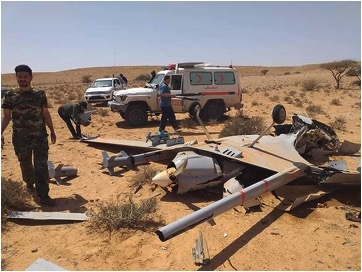Drone Losses Impact Turkey’s Fighting in Libya

Drone Losses Impact Turkey’s Fighting in Libya
Scott Crino and Andy Dreby
Unlike other conflict zones in the world, Libya experienced a steep increase in fighting last month. While the effects of Covid-19 lessened hostilities just about every place else, the United Nations recognized Government of National Accord or GNA launched a counteroffensive against the HAF, the armed forces of Khalifa Haftar, to break the HAF’s encirclement of Tripoli and Misrata. For those who monitor the happenings in Libya to see changes in irregular warfare tactics and technologies, the April fighting produced significant lessons learned, especially with respect to drones and counter drone technology. These included the employment of unmanned “kamikaze” loitering munitions by the GNA and HAF, the appearance of handheld counter drone systems, and advanced commercial-off-the-shelf flight components being used to support reconnaissance and surveillance.

Turkish Bayraktar TB2 Drone shot down near Bani Walid, Libya, 17 April 2020. Social Media Source: Harry Boone. @towersight. Twitter, https://twitter.com/towersight/status/1251200791572090880.
For us at Red Six, last month’s drone war in Libya also reinforced reservations we had about the capabilities of the Turkish drone fleet which flew in support of the GNA. Those concerns arose from the events we saw in Syria in March, where Turkey used their Bayraktar TB2 and Ankir-S drones with much success against the Syrian army. In the aftermath of the Syrian fighting, many analysts saw in Turkey, the rise of a new drone superpower, but our assessment was more ambivalent. In an article we published in the Small Wars Journal, we questioned the Turkish drones operational reach, lethality and survivability. We expected issues related to the sustainability and survivability of the Bayraktars in Syria, would appear again in future operations. As events happened in Libya, this seems true. During the fighting, we tracked eight different Bayraktar crash sites which was quite likely a most of Turkey’s Bayraktars there.
The GNA called their offensive, Operation Peace Storm. Its goal was to break the strategic impasse between the GNA and HAF. At first, the GNA was very successful, as it recaptured a series of towns northwest of Tripoli along the Mediterranean Coast. During this time, the Turkish Bayraktars were instrumental to GNA forces by interdicting HAF supply lines and killing HAF field commanders. But as Ramadan approached and the GNA moved further from Tripoli, their formations began to lose momentum. Currently, the GNA’s advance is stalled outside Tarhuna to Tripoli’s south and the Al-Watiya airfield to the west, although Al‑Watiya was reportedly under regular attack. Certainly, there are multiple reasons for the flagging GNA advance but one likely factor is the loss of the air cover provided by Turkey’s Bayraktars.
Besides aircraft losses, there were other parallels between the April’s Bayraktar operations in Libya and those in Syria a month earlier. Most importantly was context. In each case, Turkey used its Bayraktars to bring vital fighting power to allies who were besieged. In Libya, the HAF had the GNA surrounded, while in Syria, Turkey’s proxy forces in the country’s north were slowly being rolled-up by Damascus’ forces and its allies, Russia and Hezbollah. Also, in common, in Libya as well as Syria, Turkey enjoyed the element of surprise.
The impact of Turkey’s drones in Libya last month was undeniable; however, the HAF’s air defenses did cause them a lot of trouble. The HAF’s counter drone systems included Russian Pantsir missile systems, heavy machine guns, and possibly a mysterious Israeli system provided to the HAF by the U.A.E.
Last note, Turkey’s drone tempo in Libya was high in February, but almost stopped in March during their operation in Syria, and then, began again in Libya at full force in April. The alternating between battlefields implies Turkey was weighting their main efforts. This is a smart approach, but it also suggests limitations, possibly related to command structure, intelligence infrastructure or logistics base, which constrain Ankara’s ability to conduct simultaneous drone campaigns in different theaters.
At this moment, the effect of last month’s battle on the eventual political outcome in Libya is indeterminate. And, it is unknown whether the current slow-down in fighting in Libya becomes the new status quo or is just a tactical pause to let the two belligerents reorganize and reconstitute themselves. Narrowly, in the upcoming months, it will be quite interesting to see how Turkey adapts its drone tactics to account for the HAF’s growing air defense capability.
Initially posted on LinkedIn, 9 May 2020, https://www.linkedin.com/pulse/drone-losses-impact-turkeys-fighting-libya-scott-crino-dreby.






